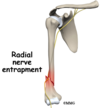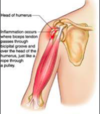15 - T&O Shoulder and Arm Flashcards
How are rotator cuff tears classified?
Acute (<3 months) or Chronic (>3 months)
Partial or Full Thickness
Full thickness small (<1cm), medium (1-3cm), large (3-5cm) or massive (>5cm)

What is the pathophysiology and some risk factors for rotator cuff tears?
Pathophysiology
Acute: in tendons with pre-existing degeneration with minimal froce
Chronic: degeneratice microtears from overuse
Risk Factors
- Age
- Trauma
- Overuse
- Repetitive overhead shoulder motions
- BMI>25
- Smoking
- Diabetes

How do rotator cuff tears present?
- Pain over the lateral aspect of the shoulder
- Inability to abduct the arm over 90 degrees
- Tenderness over greater tuberosity
Special Test: empty can, lift off test, posterior cuff test

What are some differential diagnosis for a rotator cuff tear?
- Fracture
- Glenohumeral subluxation
- Radiculopathy
- Brachial plexus injury
How do you investigate a rotator cuff tear?
- Urgent plain film radiograph to exclude fracture (unremarkable unless chronic tear then may be reduced acromiohumeral distance, sclerosis or cyst formation)
- Once fracture excluded can do US or MRI

How are rotator cuff tears managed?
Depends on tear and functional status of patient
Conservative
- For those presenting within 2 weeks of injury, unsuitable for surgery or not limited by loss of function
- Analgesia, physiotherapy, corticosteroid injections into subacromial space
Surgical
- Presenting over 2 weeks since injury or remaining symptomatic despite conservative treatment or large/massive tears
- Surgical repair

What is the prognosis with rotator cuff tears?
- Main complication is adhesive capsulitis
- If age related tears will often become larger within 5 years and become symptomatic
What is the pathophysiology and risk factors of a shoulder fracture?
Usually proxmal humerus from low energy injuries (FOOSH) with osteoporosis
Risk factors (any OA risk factors): female gender, early menopause, prolonged steroid use, recurrent falls, frailty
What are the clinical features of a shoulder fracture and what should you check on examination?
- Pain around upper arm and shoulder
- Inability to abduct arm
- Swelling and bruising of the shoulder
Check for loss of sensation in lateral shoulder and loss of power in deltoid muscle due to close relationship with axillary nerve and circumflex vessels

What investigations are done if you suspect a shoulder fracture?
- Urgent bloods with coagulation and G+S
- If suspect pathological look at serum Ca and myeloma screen
- AP, lateral scapular and axillary view plain radiographs
- CT for intraoperative planning

How are proximal humeral fractures classified?
Neer Classification
Articular segment is anatomical neck and humeral shaft is surgical neck

How are shoulder fractures managed?
Conservative (if minimally displaced and no neurovascular compromise)
- Immobilisation with polysling as gravity will help reduction
- Early mobilisation with pendular exercise at 2-4 weeks
Surgical (if displaced, open or neurovascular compromise)
- If multiple segments do ORIF or intermedullary nailing
- Hemiarthroplasty if complex

What are some complications of a shoulder fracture?
- Reduce range of motion: need to do extensive physio and rehabilitation can take about a year
- Risk of AVN of humeral head: from anterior and posterior humeral circumflex arteries. Needs hemiarthroplasty or reverse shoulder arthroplasty
What are scapular fractures and how are they managed?
- High energy trauma as lot of protection from muscles so difficult to break
- Most treated non-operatively

What is the aetiology of shoulder dislocations?
Most common is anteroinferior (anterior)
Anterior: force applied to extended, abducted, externally rotated humerus
Posterior: seizures or electrocution

What are the clinical features of a shoulder dislocation?

- Painful, reduced motility and feeling of instability
- Often asymmetry on examination with loss of shoulder contours with anterior bulge
ASSESS NEUROVASCULAR STATUS ESPECIALLY AXILLARY AND SUPRASCAPULAR NERVES

What are some associated injuries with a shoulder dislocation?
Bone:
- Bankart Lesion (fracture of anterior inferior glenoid)
- Hill Sachs defect (of humeral head)
- Fractures of greater tuberosity and surgical neck of humerus
Labral, Ligaments, Rotator cuff
- Bankart lesion (avulsion of anterior labrum)
- Glenohumeral ligament avulsion
- Rotator cuff injuries (usually in anterior and younger patients

What investigations do you do if you suspect a shoulder dislocation and what are the findings?
- Trauma shoulder series of radiographs: AP, axial, Y-scapular
- Y view helps differentiate between anterior and posterior dislocations
- Can do MRI if labral or rotator cuff injuries

How are shoulder dislocations managed?
NON-OPERATIVELY

- A to E
- Analgesia
- Closed reduction with pre and post neurovascular assessment
- Broad arm sling for around 2 weeks
- Physiotherapy to strengthen rotator cuff
- May need future surgical treatment if Hill Sachs or Bankart
What is the prognosis with a shoulder dislocation?

- Chronic pain, limited mobility, stiffness
- High rate of recurrence
- Adhesive capsulitis
- Nerve damage
- Rotator cuff injury
- OA (especially if labral tear)

What is the aetiology and risk factors of a humeral shaft fracture?
- Bimodal distribution younger and older
- Often damage radial nerve due to spiral groove disruption
Risk factors: osteoporosis, increasing age, previous fractures, pathological

How do humeral shaft fractures present?
- Pain and deformity following FOOSH or falling laterally onto adduct limb
- If radial nerve involved will have reduced sensation over 1st dorsal webspace and a weakness in wrist extension
- Always check neurovascular status, any open wounds and any concurrent injuries
































